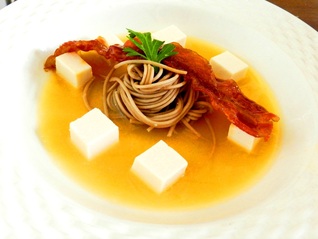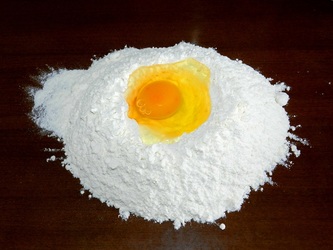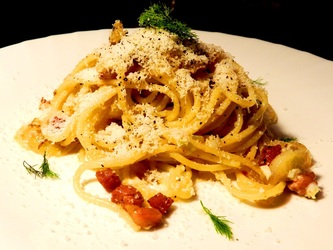
I love Japanese food - having spent almost a month and a half in Japan, I've seen it's range and potential, it's simplicity in flavor combinations and its elegance demonstrated in technique.
Coming how to a fridge with not a lot of stuff (but indeed a few Japanese-related ingredients), I decided to have a crack at making a Japanese-inspired dish myself.
Ingredients:
Tofu (silken/medium)
Miso soup paste
Buckwheat Soba
Bacon, strips
Soy sauce
Sugar
1. Prepare your miso soup: since I don't have other options (being that I live in Italy), I used miso soup paste and added it with some water and brought it up to a boil - voila! Instant miso soup (misoshiru).
2. In a non-stick pan, lay out your bacon strips and render the fat out of the bacon. If you are preparing a lot of bacon strips (and I suggest you do!), do this is batches making sure that each strip has maximal contact with the pan. After sometime, flip the strips to evenly cook both sides. Once the fat has rendered out (i.e. the opaque fatty part has turned translucent and fat has been released in the pan), remove the strips and do some more. You can use the remaining fat in the pan for other dishes (this is essentially "bacon essence") or let it become part of the sinful glaze we'll put in the bacon.
3. Put all of the rendered bacon strips in the pan. In a small container, mix one tbsp. of soy sauce with about half a tbsp. of sugar. Add just a small amount of water to help in the mixing. Raise the pan heat to high and pour this soy syrup on the bacon strips and let the syrup caramelize lightly and form a nice sticky glaze on the bacon strips. Don't let the caramel go too far out (it's gonna get bitter) and once the liquid gains viscosity and starts to bubble, turn of the heat.
4. Prepare the tofu and the soba: blanch the buckwheat soba in the hot, simmering soup - let it stay in the liquid for a couple of minutes, drain and shock with cold water. Cut up the tofu into cubes and add into the miso soup. Turn off the heat and let the tofu cook in the residual heat.
5. Plating up: Place tofu cubes neatly around the soup dish. Get the drained soba and twirl it into a neat bundle and place in the middle of the soup dish. Pour some misoshiru into the dish - just enough to cover about half of the tofu cubes. Place the bacon on top of the soba bundle. Top with a leaf of parsley.
Japanese-style clean flavors but with a rich (slightly unhealthy) twist.
Itadakimasu!
Coming how to a fridge with not a lot of stuff (but indeed a few Japanese-related ingredients), I decided to have a crack at making a Japanese-inspired dish myself.
Ingredients:
Tofu (silken/medium)
Miso soup paste
Buckwheat Soba
Bacon, strips
Soy sauce
Sugar
1. Prepare your miso soup: since I don't have other options (being that I live in Italy), I used miso soup paste and added it with some water and brought it up to a boil - voila! Instant miso soup (misoshiru).
2. In a non-stick pan, lay out your bacon strips and render the fat out of the bacon. If you are preparing a lot of bacon strips (and I suggest you do!), do this is batches making sure that each strip has maximal contact with the pan. After sometime, flip the strips to evenly cook both sides. Once the fat has rendered out (i.e. the opaque fatty part has turned translucent and fat has been released in the pan), remove the strips and do some more. You can use the remaining fat in the pan for other dishes (this is essentially "bacon essence") or let it become part of the sinful glaze we'll put in the bacon.
3. Put all of the rendered bacon strips in the pan. In a small container, mix one tbsp. of soy sauce with about half a tbsp. of sugar. Add just a small amount of water to help in the mixing. Raise the pan heat to high and pour this soy syrup on the bacon strips and let the syrup caramelize lightly and form a nice sticky glaze on the bacon strips. Don't let the caramel go too far out (it's gonna get bitter) and once the liquid gains viscosity and starts to bubble, turn of the heat.
4. Prepare the tofu and the soba: blanch the buckwheat soba in the hot, simmering soup - let it stay in the liquid for a couple of minutes, drain and shock with cold water. Cut up the tofu into cubes and add into the miso soup. Turn off the heat and let the tofu cook in the residual heat.
5. Plating up: Place tofu cubes neatly around the soup dish. Get the drained soba and twirl it into a neat bundle and place in the middle of the soup dish. Pour some misoshiru into the dish - just enough to cover about half of the tofu cubes. Place the bacon on top of the soba bundle. Top with a leaf of parsley.
Japanese-style clean flavors but with a rich (slightly unhealthy) twist.
Itadakimasu!


 RSS Feed
RSS Feed